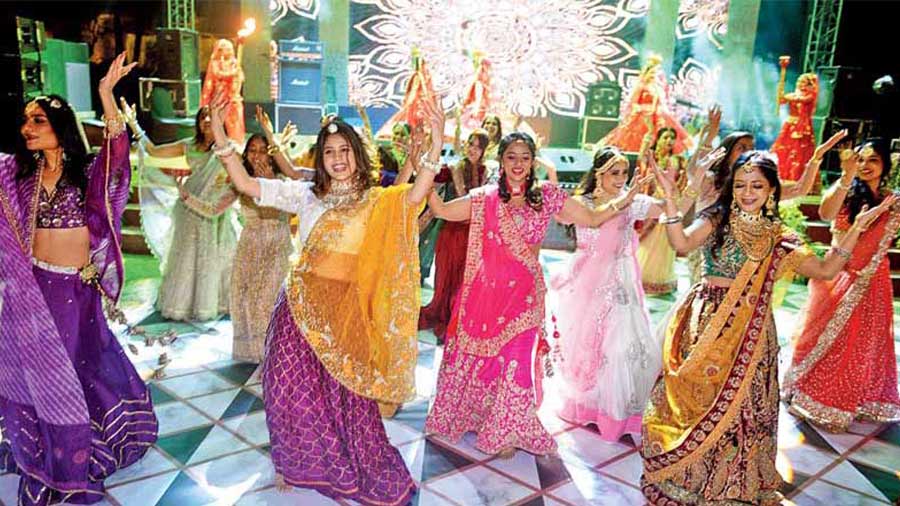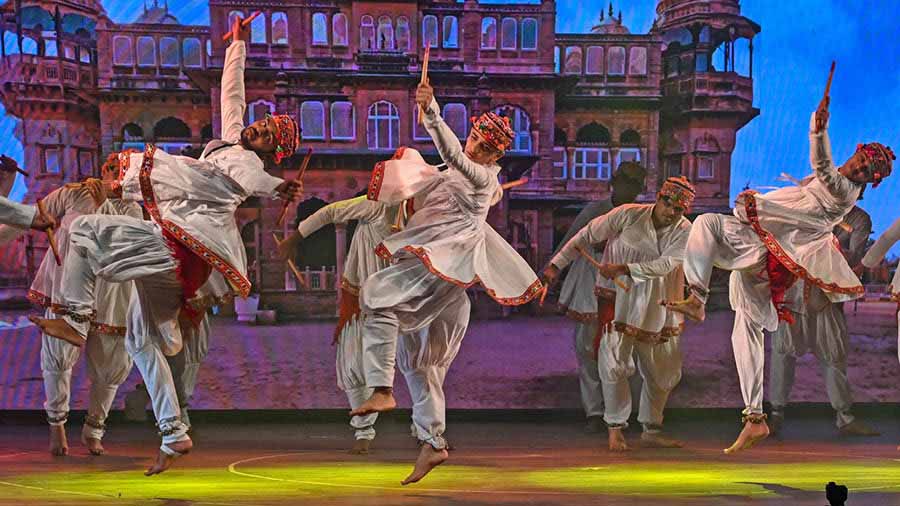The coming week isn’t just about visiting pandals all night. For many in the city, it is also about dancing till the wee hours of the night. Kolkata has a vibrant culture of Raas Garba, and over the last 70 years, the Gujarati community has gone from relative anonymity to organising packed shows in some of the largest venues. My Kolkata takes a closer look.
Pami Shah, 83, started learning Kathak from the age of five. When she was 12, a dancer was brought from Ahmedabad to teach children garba. “The Gujarati population in Kolkata was limited in the 1950s, and these classes were done with the vision of creating a garba culture. The first competitions and garba events were organised by a group called Indian National Theatre (INT). I was instantly drawn to them, and that’s where my journey started,” she said. By the time Pami was 17, she was juggling garba with college and participated in competitions organised by multiple communities including the Patidar Samaj and Shree Bhawanipur Gujrati Stree Mandal. She is currently the vice president of the latter.
“Back then, the spot where Neelkamal Apartment stands today, was a ground where Navratri programmes were held. The number of people who knew how to play garba were limited, so people would often request my parents to let me perform at their events! There were barely five or six people serious about it when I started. We would have to get choreographers and singers from outside since we didn’t have recorded music. There weren’t designers either, and we would make our own dresses,” she reminisces.

Pami Shah, vice president of the Shree Bhawanipur Gujrati Stree Mandal
Indian dancer and choreographer Shila Mehta also entered the scene in the 1960s. While her training was in Kathak, which she calls her first love, garba reflected her roots. She fondly remembers participating in dramas and competitions organised by INT, which had all the buzz at the time, with teachers from Ahmedabad being roped in by groups like Stree Mandal and Balmandir. “Groups sprang up on the basis of community, which were called Samajs. While competitions had prizes, the focus was always on creativity,” says Shila, who now divides her time between Mumbai and the United States.
Back then, Kamani Jain Bhavan and Lakshmi Narayan Mandir were among the few to host an expansive 9-day Navratri celebration. “There were lots of small groups, particularly in Burrabazar, but only a few venues operated on a big scale. The prizes weren’t very lucrative either, and people participated for the joy of dancing,” smiles Shila.
At the time, the Gujarati population in the city was divided into two areas, Burrabazar and Bhawanipur, with kids from the community either studying in The Calcutta Anglo Gujarati School or J. J. Ajmera High School. Mehta remembers that there was a distinct sense of groupism between the two, and one that crept into garba.
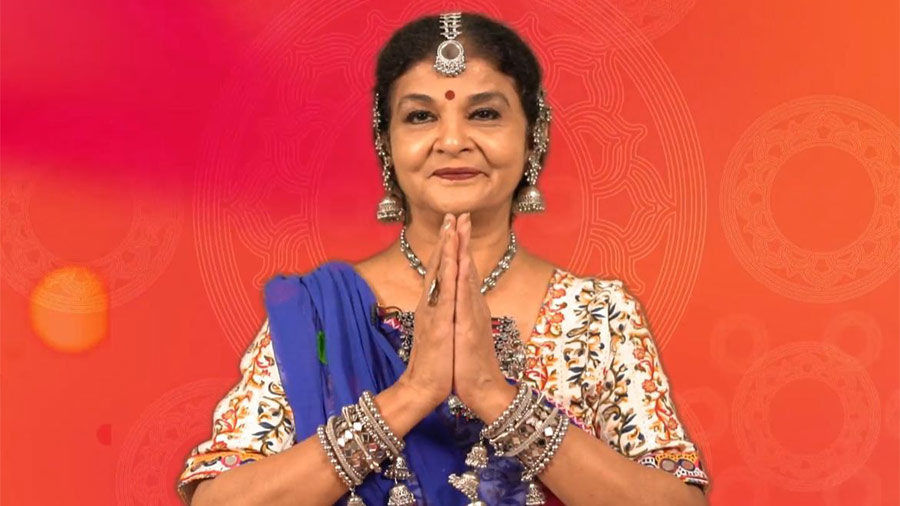
Indian dancer and choreographer Shila Mehta
The perfect blend of both groups was being brewed into a group named Nukkad. Amit Sanghvi, the current joint secretary of Gujarat Club is filled with nostalgia when he looks back upon the garba culture of Burrabazar. He grew up in 121, Central Avenue, right opposite Mohammad Ali Park. His father had started a small group called Avenue Mitra Mandal, where they would organise garba on all nine days of Navratri. “We didn’t rope in an orchestra from outside. Amongst the residents, someone would play the tabla, another would play the manjeera, and my mother would sing. We set up a mandir for Ambe Maa in the middle of the chowk and tied a tarpaulin above it. In the evenings, young girls would be invited to every house in the building to play garba for a few hours, and would get a gift. The residents would come down at 11pm every night, and dance till 3am every morning. This culture, referred to as Sheri Na Garba, was prevalent in all Gujarati dominated buildings in Burrabazar, including Tulsi Bhavan, Raja Bhavan and Mishra Bhavan,” he says. Tradition was paramount, and the garba would always commence with aarti and prasad.
The celebrations were so fundamental to Amit’s Navratri that despite moving to Bhowanipore in 1980, he still kept going back to 121, Central Avenue, for years after that, just to play garba. Simultaneously, he began spending a lot of time with his friends at Heysham Row, playing cricket and badminton every evening. Apart from this, he and his friends would also play raas garba. “One Navratri, Shilaben spotted me and my friend dancing at Tivoli Court, and asked if we wanted to participate in one of her shows at Vidya Mandir. We roped in our friends too, and it was great exposure for us,” he adds. From that point on, for the next 17 years, Amit and his friends became known as the group, Nukkad, and they would travel around the city, just to play garba at different venues each night, winning many trophies. “We did this for 17 years, till we got married and had children.

Nukkad performing at one of their first programmes, in the 1980s
The scene kept growing in the 1980s, with more people participating in competitions. A certain Alka Yagnik became the talk of the town. Barely a teenager, she would sing at all the garba events in the city and mesmerised dancers, until her fame grew and she left for Mumbai.
Meanwhile, Shila worked closely with music director Bhupendra Pandya to establish a garba culture within the Marwari community, with events at venues like Bengal Rowing Club and Jyotirmai Club. She even helped organise raas events for Birla Schools at Netaji Indoor Stadium!
Not only did Shila become a name to reckon with in Kolkata’s garba community, but her increased workload led her to establish the Nupur Zankar Academy Of Performing Arts & Research Centre in 1983. She says, “One of our first projects was Rasotsav, where I used my classical background to incorporate sahitya into folk dance and make it richer. It was the first raas programme to be performed to recorded music, and the first Gujarati event at the newly opened GD Birla Sabhaghar.”
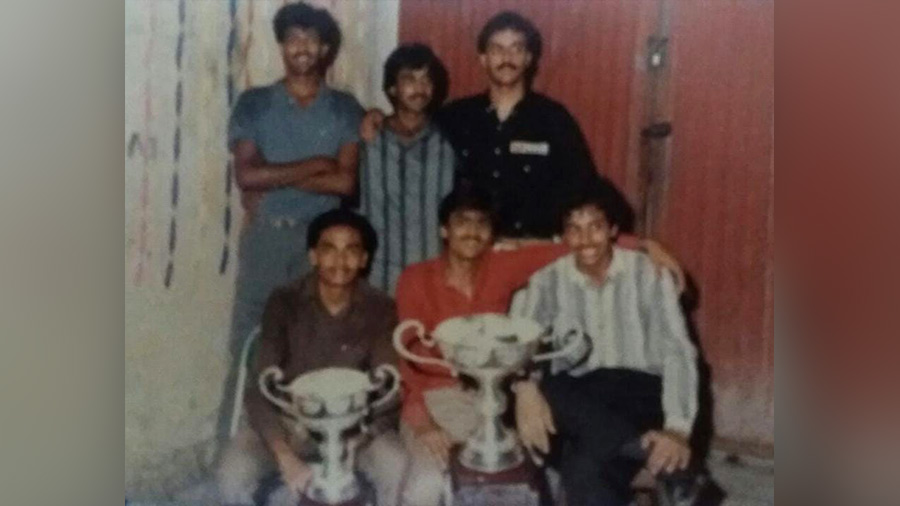
The ‘Nukkad’ gang with trophies
Nupur Zankar was also invited to perform a Gujarati folk dance by Doordarshan 2 for their inaugural show when they started operations in Kolkata. “Youngsters had noticed the rise of garba, and now wanted to learn it at a more advanced level. In the mid-1980s, I started teaching workshops at The Bhawanipur Education Society College. The 15-day workshops would happen in the summer, and I received over 500 registrations,” Shila chuckles. “I noticed that there was very little desire for depth, and decided to incorporate some teachings of kathak into garba.” However, Shila’s vision was clear: innovation should not tarnish tradition. “I was so interested to understand the culture that I travelled across Saurashtra to learn the authentic language of Gujarati dance, and even studied books on rhythm from Mumbai. I was one of the first Kolkattans to begin teaching.” Shila explains how her Kathak taalim allowed her to bring rhythmic variations to raas garba, while keeping its core intact. “I incorporated these nuances to my teaching, and students embraced it with interest.”
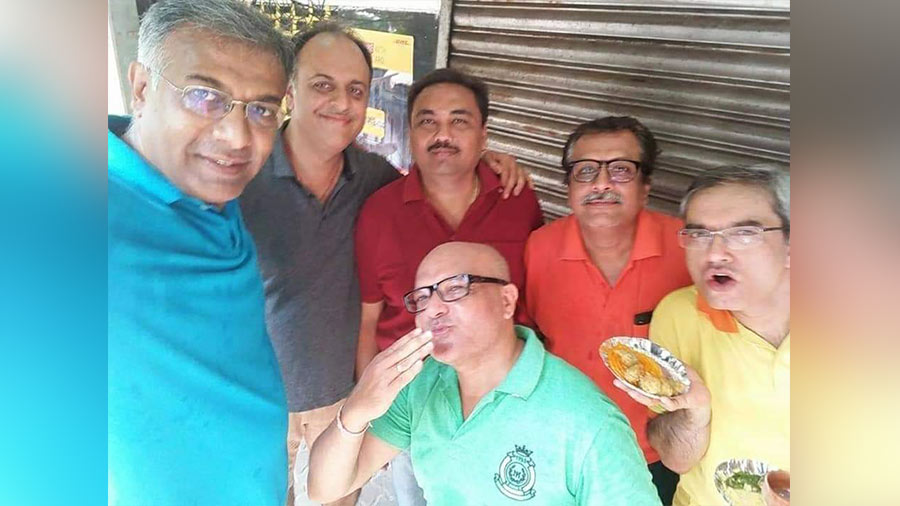
The Nukkad gang now
Pami also remembers being starstruck when she met Dilip Kumar, who had come to New Empire for an event where she performed. “He was delighted to see that we had kept the authentic Gujarati garba alive outside Gujarat. Unlike other cities, Kolkata believes in originality, but upon going outside, I see weird fusion forms of garba and wonder if people are doing yoga or aerobics,” she laughs.
As for Nukkad, they were consistently scaling new heights, even being invited to places like Jamshedpur to put up shows. Their efforts culminated in 1992, when they put up a show called, Vartul, choreographed by Shila. The three-hour performance was a homage to Gujarati folk dance, and the popularity resulted in a sequel in 1994, performed at Kala Mandir. “A lot of young boys and girls met through my raas garba events and found their life partners in each other, manifesting into real Radha-Krishnas. One of them was Amit,” Shila beams. Unfortunately, parenthood and responsibilities led to many members moving on. Shila had also left the city in the 1990s, leading to a lull in the garba scenario.
“Our generation worked really hard, going around the building with a notebook, putting all our powers of persuasion to collect chanda of Rs 5 or 10. The new generation doesn’t want to do that. We would play for happiness and fun, but the heavy rewards in competitions have diluted this spirit,” Amit sighs. He adds that while people from his generation discovered garba in their late teens and played for at least 15 years, today kids start from the age of 7, and don’t want to play it for more than 6 to 7 years. “Earlier, we would join our family business whilst in college and settle down sooner, but now that the demands of higher education and the corporate world have gone up, it has drastically reduced the desire to play garba. I have seen this change only in the last decade.”
He also attributes this to the increasing rewards in competitions, which have incentivised parents to push kids with the slightest potential to participate in every competition in the city, lugging around heavy dresses that cost upwards of Rs 1,000 every day in rent. “Our parents never cared about where we participated or what we won. We enjoyed dancing without any tension. We never even had to pay an entry fee. The moment a commercial angle comes in, things change,” rues Amit.
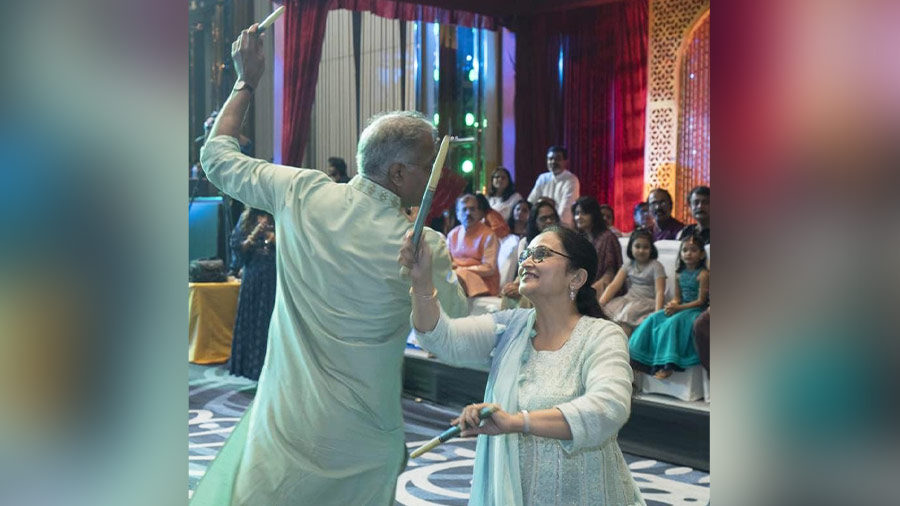
Amit playing dandiya with wife Minal at JW Marriott
The commercial prospects have also led to a huge spike in garba and dandiya classes in the city, with many people finding renewed interest. Most of these classes commence five months before Navratri. The landscape has significantly evolved in the last few years, with the concept of ‘Pre-Navratri’ taking over, where celebrations start almost 10 days before Mahalaya, and extend up till Sharad Purnima. This has ensured that the festive mood continues for a month, without directly clashing with Durga Puja. The drawback is that the culture of 9-day celebrations has declined, with most venues hosting garba nights only on 3 or 4 days. “Liluah has a thriving Patel community that celebrates a 9-day Navratri there. But of the ones in Central Calcutta, Madan Mansion is the only one left that continues to organise a traditional celebration on all nine days,” Amit says.
But the connection to heritage isn’t lost. Kolkata continues to have huge Navratri celebrations at JW Marriott every year, where the Gujarati community comes together as one. Following the death of two of their core members in the pandemic, Nukkad reunited last month to put up two packed shows in Kala Mandir, after a hiatus of three decades. Shila returned to the city to choreograph them, and remarked how the children instantly picked up traditional folk dance forms that they had never seen. “There is a certain joy and belongingness in your roots, and they will always call out to you. No matter where we live, being Gujarati and playing garba is in our genes,” she signed off.
